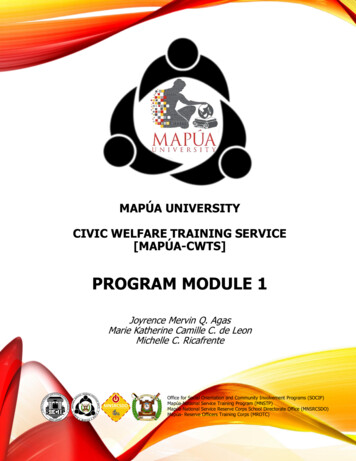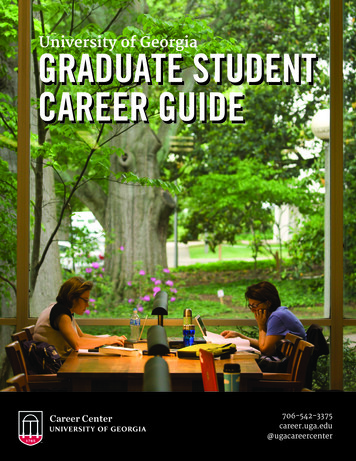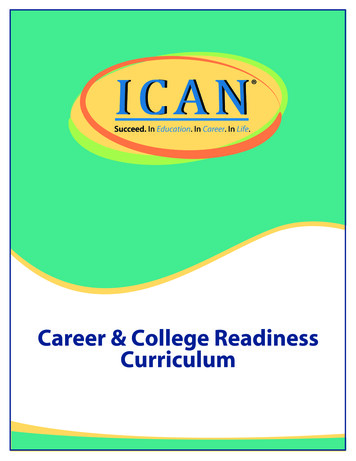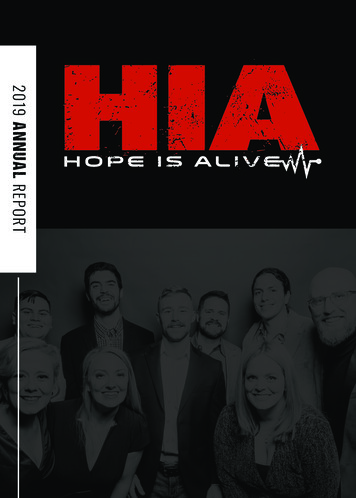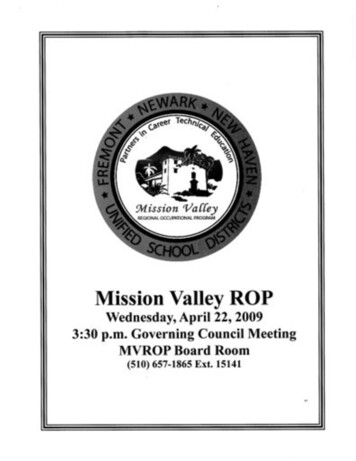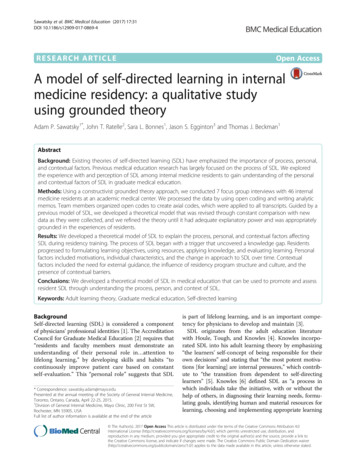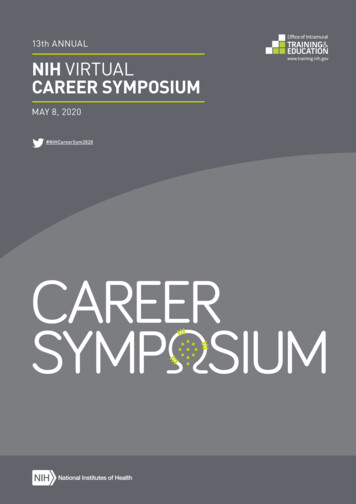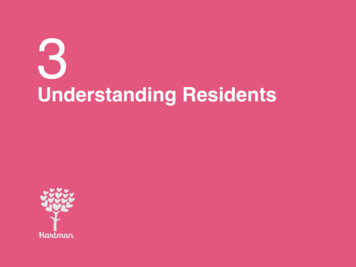
Transcription
3Understanding Residents
31. Identify basic human needsUnderstanding ResidentsDefine the following term:psychosocial needsneeds that involve social interaction, emotions, intellect, andspirituality.2
31. Identify basic human needs Understanding ResidentsThese are the basic physical needs of human beings:Food and waterProtection and shelterActivitySleep and restComfort, freedom from pain3
31. Identify basic human needs Understanding ResidentsSome nursing assistant tasks address residents’ physical needs,including the following:Assisting with eatingAssisting with eliminationAssisting with bathingAssisting with grooming4
31. Identify basic human needs Understanding ResidentsThese are six psychosocial needs of human beings:Love and affectionAcceptance by othersSafety and securitySelf-reliance and independence in daily livingContact with othersSuccess and self-esteem5
31. Identify basic human needs Understanding ResidentsWhen a person’s psychosocial needs are not met the responsemay WithdrawalDepression6
31. Identify basic human needsUnderstanding ResidentsThink about this question:How could the strong negative feelings associated with unmetpsychosocial needs interfere with residents’ health?7
3Understanding ResidentsTransparency 3-1: Maslow’s Hierarchy of Needs8
31. Identify basic human needsUnderstanding ResidentsThink about these questions:What do self-esteem and self-actualization mean to you?Which of the needs in Maslow’s Hierarchy of Needs are physical?Which are psychosocial?Are any of the needs more important than the others?9
31. Identify basic human needsUnderstanding ResidentsDefine the following term:masturbationto touch or rub sexual organs in order to give oneself oranother person sexual pleasure.10
31. Identify basic human needsUnderstanding ResidentsREMEMBER:Respect and privacy are very important when encountering anysexual situation.11
3It is important for NAs to remember the following about residents’sexual needs and sexual situations: People continue to have sexual needs throughout their lives. Humans express their sexuality through different behaviors. Knock and wait for a response before entering residents’rooms. Provide privacy if you encounter a sexual situation. Be open and nonjudgmental. Respect residents' sexual orientation and gender identity. Use the pronouns and names that transgender residentswish to use.12Understanding Residents1. Identify basic human needs
31. Identify basic human needsUnderstanding ResidentsIt is important for NAs to remember the following about residents’sexual needs and sexual situations (cont'd): Respect residents’ sexual orientation. Honor Do Not Disturb signs. Do not view expressions of sexuality by elderly as cute ordisgusting.13
3 Myth #1: Older men are not capable of having sexualrelations. There are some physical changes that may alter theway a couple engages in sexual relations. Men may need moredirect contact, may take longer, and may need longer betweensexual activities to perform again. However, many men continueto have satisfying relations well into old age. Myth #2: After menopause women are not interested insexual relations. Many women relax and enjoy sex more inlater years. With no fear of pregnancy, many women feel muchfreer. There may be some physical changes, such as lesslubrication, but there are remedies available. Communication withtheir physicians is important. The reason many older women stophaving sex is because they lose their partners when theirpartners die.14Understanding ResidentsHandout 3-1: Myths About Older Adults and Sexuality
3 Myth #3: Any expression of sexuality by older people iseither disgusting or cute. This attitude deprives older people oftheir right to dignity and respect. Older adults have the sameneeds and rights to express their sexuality as other age groups,and they may do so in the same ways. In all age groups there isa wide variety of behavior. This is also true of older people.It is true, however, that our society discourages this expression bythe messages sent through jokes, advertisements, and the media.Older people see and hear these messages and may believe thatthere is something wrong with them if they feel or act on theirdesires.15Understanding ResidentsHandout 3-1: Myths About Older Adults and Sexuality (cont’d)
31. Identify basic human needsResidents must be protected from unwanted sexual advances. If anNA sees sexual abuse happening, he should remove the residentfrom the situation and take the resident to a safe place. He shouldthen report to the nurse immediately.16Understanding ResidentsREMEMBER:
31. Identify basic human needs Learn about their religions or beliefs. Respect residents’ decisions to participate in, or refrain from,food-related rituals. Encourage participation in religious services for residentswho are religious. Respect all religious items. Report requests to see clergy to nurse. Allow privacy for clergy visits. If asked, read religious materials aloud. Refer resident to spiritual resources if requested.17Understanding ResidentsNAs can help residents meet their spiritual needs in these ways:
3Transparency 3-2: Not Permitted Understanding ResidentsThe following are not permitted regarding residents' spiritual/religious needs:Trying to change someone’s religionTelling residents their belief or religion is wrongExpressing judgments about a religious groupInsisting that residents join religious activitiesInterfering with religious practicesDiscussing your personal beliefs or opinion either directly orindirectly18
31. Identify basic human needsUnderstanding ResidentsThink about these questions:Why should you not be judgmental about other people’s beliefs?Why should you not impose your beliefs on your residents?Would your political ideas be appropriate topics of conversationwith your resident or his family?What are some appropriate topics of conversation with residentsand their families?19
32. Define holistic careUnderstanding ResidentsDefine the following term:holistic carea type of care that involves caring for the whole person—themind as well as the body.20
32. Define holistic careCan you think of an example of how NAs can provide holistic careto residents?21Understanding ResidentsThink about this question:
3Understanding Residents3. Explain why promoting independence and self-care isimportantResidents in LTC facilities may be experiencing any of theselosses: Loss of spouse, family, or friendsLoss of workplace and its relationshipsLoss of ability to go placesLoss of ability to attend services and meetings at their faithcommunities Loss of home and personal possessions Loss of health and ability to care for themselves Loss of ability to move freely22
3Residents in LTC facilities may be experiencing any of these losses(cont'd): Loss of pets LGBTQ residents may fear the loss of a comfortable oraccepting environment23Understanding Residents3. Explain why promoting independence and self-care isimportant
3Understanding Residents3. Explain why promoting independence and self-care isimportantLoss of independence can cause: Poor self-imageAngerFeelings of helplessness, sadness, and hopelessnessFeelings of uselessnessIncreased dependenceDepression24
3Understanding Residents3. Explain why promoting independence and self-care isimportantNAs promote independence in residents when they do thefollowing: Encourage residents to do as much as possible forthemselves, no matter how long it takes. Be patient. Allow residents to make choices.25
3Understanding Residents3. Explain why promoting independence and self-care isimportantREMEMBER:It is important that NAs never treat residents like children.Residents are adults who can make their own choices and shouldcare for themselves as independently as possible.26
34. Identify ways to accommodate cultural differencesUnderstanding ResidentsDefine the following term:cultural diversitythe different groups of people with varied backgrounds andexperiences who live together in the world.27
34. Identify ways to accommodate cultural differences Understanding ResidentsCulture plays a part in determining all of the following:LanguageReligionFood preferencesTouch28
3Understanding a little bit about common religious groups may beuseful. Common religions, listed alphabetically, follow:Buddhism: Buddhism started in Asia but has many followers inother parts of the world. Buddhism is based on the teachings ofSiddhartha Gautama, called Buddha. Buddhists believe that life isfilled with suffering that is caused by desire and that suffering endswhen desire ends. Buddhism emphasizes meditation. Properconduct and wisdom release a person from desire, suffering, and arepeating sequence of births and deaths (reincarnation). Nirvana isthe highest spiritual plane a person can reach. It is the state ofpeace and freedom from worry and pain. There are many Buddhisttexts. The Tipitaka or Pali Canon is the standard scripturecollection. The Dalai Lama is considered to be the highest spiritualleader.29Understanding ResidentsHandout 3-2: Religions and Dietary Practices
3Christianity: Christians believe Jesus Christ was the son of Godand that he died so their sins would be forgiven. Christians may beCatholic or Protestant. There are many subgroups ordenominations (such as Baptist, Episcopalian, Evangelical,Lutheran, Methodist, Mormon, Presbyterian, and Roman Catholic).Christians may be baptized and may receive communion as asymbol of Christ's sacrifice. They may attend church on Saturdaysor Sundays. Some Christians may try to share their beliefs andconvert others to their faith. The Christian Bible is the sacred textand is divided in to the Old Testament and the NewTestament. Religious leaders may be called priests, ministers,pastors, preachers, or reverends.30Understanding ResidentsHandout 3-2: Religions and Dietary Practices (cont’d)
3Hinduism: Hinduism is the dominant faith of India, but it ispracticed in other places as well. According to Hindu beliefs, thereare four purposes of life: acting morally and ethically (Dharma),pursuing prosperity (Artha), enjoying life (Karma), andaccomplishing enlightenment (Moksha). People move throughbirth, life, death and rebirth. How a person moves towardenlightenment is determined by karma. Karma is the result ofactions in past lives and actions in this life can determine one'sdestiny in future lives. Hindus advocate respect for all life, andsome Hindus are vegetarians. Hindus who do eat meat almostalways refrain from eating beef. Hindus follow the teachings ofancient scriptures like the Vedas and Upanishads, as well as othermajor scriptures. Holy men are called Sadhus.31Understanding ResidentsHandout 3-2: Religions and Dietary Practices (cont’d)
3Islam: Muslims, or followers of Mohammed, believe that Allah (theArabic term for God) wants people to follow the teachings of theprophet Mohammed. Many Muslims pray five times a day facingMecca, the holy city for their religion. Muslims also fast during amonth-long observation called Ramadan. Muslims worship atmosques and do not drink alcohol or eat pork. There are otherdietary restrictions, too. The Qur'an (Koran) is the sacred text ofIslam. Islamic religious leaders may be called ayatollah, caliph,imam, mufti, or mullah, among other titles.32Understanding ResidentsHandout 3-2: Religions and Dietary Practices (cont’d)
3Judaism: Judaism is divided into Reform, Conservative, andOrthodox movements. Jewish people believe that God gave themlaws through Moses in in the form of the Torah (the sacred text),and that these laws should order their lives. Jewish services areheld in synagogues or temples on Friday evenings and sometimeson Saturdays. Some Jewish men wear a yarmulke, or smallskullcap, as a sign of their faith. Some Jewish people observedietary restrictions. They may not do certain things, such as workor drive, on the Sabbath day (called Shabbat), which lasts fromFriday sundown to Saturday sundown. Religious leaders are calledrabbis.33Understanding ResidentsHandout 3-2: Religions and Dietary Practices (cont’d)
3Spirituality concerns a person’s beliefs about the spirit or the soul.It may center on how a person relates to his community, to nature,or to the divine. It may involve reflection and contemplation and asearch for inner peace. It may elate to a person's beliefs about themeaning of life. Spiritual practices can include meditation or prayer,but spirituality does not have to encompass religious beliefs. Manypeople consider themselves to be spiritual but not religious.Many Native Americans (American Indians) follow many differentspiritual traditions and practices. An emphasis is placed on thepersonal and the communal, rather than the institutional, and thereis a deep connection with nature. There are many varied practicesand rituals.34Understanding ResidentsHandout 3-2: Religions and Dietary Practices (cont’d)
3Some people may not believe in God or a higher power and identifythemselves as agnostic. Agnostics claim that they do not know orcannot know if God exists. They do not deny that God might exist,but they feel there is no true knowledge of God’s existence.Atheists are people who believe that there is no God. This isdifferent from what agnostics believe. Atheists actively deny theexistence of any deity (higher power). For many atheists, this beliefis as strongly held as any religious belief.35Understanding ResidentsHandout 3-2: Religions and Dietary Practices (cont’d)
3Many religious beliefs include dietary restrictions. These are rulesabout what and when followers can eat. Some examples are listedbelow. Many Buddhists are vegetarians, though some include fish intheir diet. Some Christians, particularly Roman Catholics, do not eat meaton Fridays during Lent. Many Jewish people eat kosher foods, do not eat pork, and donot eat lobster, shrimp, and clams (shellfish). Kosher food is foodprepared in accordance with Jewish dietary laws. Kosher andnon-kosher foods cannot come into contact with the same plates.Jewish people who observe dietary laws may not eat meatproducts at the same meal with dairy products. Mormons may not drink alcohol, coffee, or tea. They may not usetobacco in any form.36Understanding ResidentsHandout 3-2: Religions and Dietary Practices (cont’d)
3 Muslims do not eat pork and may avoid certain birds. They maynot drink alcohol. Muslims may have regular periods of fasting.Fasting means not eating food or eating very little food. Some people are vegetarians and do not eat any meat forreligious, moral, or health reasons. Some people are and do not eat any animals or animal products,such as eggs or dairy products. Vegans may also not use orwear any animal products, including leather.37Understanding ResidentsHandout 3-2: Religions and Dietary Practices (cont’d)
34. Identify ways to accommodate cultural differencesUnderstanding ResidentsIn small groups, ask each other these questions: Where did you grow up? Did you like it? What kinds of food were served at your house? What languages do you know?38
34. Identify ways to accommodate cultural differencesHow can knowing about the residents she cares for help an NA doa better job meeting their needs?39Understanding ResidentsThink about this question:
34. Identify ways to accommodate cultural differencesNAs should focus on compassionate, respectful, and culturallysensitive care. They should treat residents as the residents wish tobe treated, not as the NA would want to be treated. This is part ofperson-centered care.40Understanding ResidentsREMEMBER:
35. Describe the need for activity Understanding ResidentsPhysical activity has the following positive effects:Lessens risk of illnessesRelieves symptoms of depressionImproves mood and concentrationImproves body functionLowers risk of fallsImproves sleepImproves ability to cope with stressIncreases energyIncreases appetite41
35. Describe the need for activity Understanding ResidentsInactivity can cause the following problems:Loss of y tract infectionSkin breakdown and pressure ulcersConstipationBlood clotsDulling of senses42
36. Discuss family roles and their significance in health careUnderstanding ResidentsThere are many different family types, including the following: Nuclear families Single-parent families Married or committed couples of the same sex or oppositesex Extended families Blended families43
36. Discuss family roles and their significance in health care Understanding ResidentsFamilies may participate in the care of residents in these ways:Helping to make care decisionsCommunicating with care teamGiving support and encouragementConnecting to outside worldGiving assurance to dying residents44
36. Discuss family roles and their significance in health careResidents’ families are likely experiencing significant adjustments.NAs should be respectful. They should allow privacy for visits andobserve and report the effect of visits on residents.45Understanding ResidentsREMEMBER:
36. Discuss family roles and their significance in health careUnderstanding ResidentsREMEMBER:NAs should take the time to ask families questions. NAs shouldcommunicate with families and show them that NAs have time forthem.46
37. Describe the stages of human growth and developmentUnderstanding ResidentsInfancy (Birth to 12 months) Grow and develop quickly Development is from head down47
37. Describe the stages of human growth and developmentUnderstanding ResidentsToddlerhood (Ages 1 to 3) Formerly dependent, now gaining independence and bodycontrol Learn to speak, gain coordination, and bladder and bowelcontrol May have tantrums or whine to get their way48
37. Describe the stages of human growth and developmentUnderstanding ResidentsPreschool Years (ages 3 to 6) More social relationships Play cooperatively and learn language Learn right from wrong49
37. Describe the stages of human growth and developmentUnderstanding ResidentsSchool-Age years (Ages 6 to 10) Cognitive development (thinking and learning) Learn to get along with others in their peer group Develop a conscience and self-esteem50
37. Describe the stages of human growth and development Understanding ResidentsPreadolescence (Ages 10 to 13)Growing sense of identityStrongly identify with peersRelatively calm periodImaginary fears give way to fears based in real world51
37. Describe the stages of human growth and development Understanding ResidentsAdolescence (Ages 13 to 19)Onset of pubertySecondary sex characteristicsReproductive organs begin to functionConcern for body image and peer acceptanceChanging moods52
37. Describe the stages of human growth and development Understanding ResidentsYoung Adulthood (ages 19 to 40), people oftenSelect an educationSelect a careerSelect and live with a mateRaise childrenDevelop a satisfying sex life53
37. Describe the stages of human growth and developmentUnderstanding ResidentsMiddle Adulthood (Ages 40 to 65) More comfortable and stable Physical changes related to aging occur54
37. Describe the stages of human growth and development Understanding ResidentsLate adulthood (65 years and older)Many physical and psychosocial changesLoss of physical healthLoss of friends and jobsLose friends55
37. Describe the stages of human growth and developmentageismprejudice toward, stereotyping of, and/or discrimination againstolder persons or the elderly.56Understanding ResidentsDefine the following term:
31.2.3.4.5.6.7.People over 80 years old cannot live by themselves.Most older adults are lonely and depressed.Older adults are not able to adjust to changes.Most older adults are ill or disabled in some way.Older adults can stay active by pursuing favorite hobbies.Good health can help older adults live independently.Normal changes of aging do not include diseases, disabilities,or dependence on others.57Understanding ResidentsTransparency 3-3: True or False
37. Describe the stages of human growth and development Understanding ResidentsRemember these facts about aging:Older adults have many different capabilities.Stereotypes are false.Older persons are usually active.Aging is a normal process, not a disease.Aging persons need to adjust to change.They do not need to be dependent.58
37. Describe the stages of human growth and development Understanding ResidentsNormal changes of aging include the following:Thinner, drier, more fragile, and less elastic skinWeaker, less toned musclesLess dense, more brittle bonesLess sensitive nerve endings in skinSlower responses and reflexesShort-term memory lossWeaker senses59
37. Describe the stages of human growth and development Understanding ResidentsNormal changes of aging (cont’d):Less efficient heartLess oxygen in the bloodDecreased appetiteMore frequent urinary eliminationLess efficient, slower digestionDecreased hormone levelsWeakened immunityLifestyle changes60
3Remember that the following are not considered normal changes ofaging: DepressionSuicidal thoughtsUnable to think logicallyPoor nutritionShortness of breathIncontinence61Understanding Residents7. Describe the stages of human growth and development
38. Discuss developmental disabilitiesdevelopmental disabilitiesdisabilities that are present at birth or emerge during childhoodthat restrict physical and/or mental ability.62Understanding ResidentsDefine the following term:
38. Discuss developmental disabilities Understanding ResidentsThe following are important points about intellectual disabilities:Not a disease or psychiatric illnessBelow-average mental functioningMay have limited ability to live independentlyHave the same emotional and physical needs as others63
3NAs should remember the following when caring for residents withan intellectual disability, including meeting emotional and physicalneeds: Treat adult residents as adults.Praise and encourage often.Help teach ADLs by dividing a task into smaller units.Promote independence.Encourage social interaction.Repeat words you use to make sure they understand.Be patient.64Understanding Residents8. Discuss developmental disabilities
39. Describe some types of mental health disordersmajor depressive disordera type of mood disorder that causes pain, fatigue, apathy,sadness, irritability, anxiety, sleeplessness, and loss ofappetite, as well as other symptoms; also called depression orclinical depression.apathya lack of interest in activitiesbipolar disordera type of mood disorder that causes mood swings, changes inenergy levels and the ability to function, periods of extremeactivity, and periods of extreme depression.65Understanding ResidentsDefine the following terms:
39. Describe some types of mental health disordersanxietyUneasiness, worry, or fear, often about a situation or condition.generalized anxiety disorder (GAD)an anxiety disorder that is characterized by chronic anxiety andworry, even when there is no cause for these feelings.panic disordera disorder characterized by a person having regular panicattacks or living with constant anxiety about having anotherattack.66Understanding ResidentsDefine the following terms:
39. Describe some types of mental health disordersobsessive-compulsive disorder (OCD)an anxiety disorder characterized by obsessive behavior orthoughts, which may cause the person to repeatedly perform abehavior or routine.posttraumatic stress disorder (PTSD)an anxiety disorder caused by experiencing or witnessing aatraumatic experience.67Understanding ResidentsDefine the following terms:
39. Describe some types of mental health disordersphobiaan intense irrational fear of or anxiety about an object, place, orsituation.claustrophobiathe fear of being in a confined space.schizophreniaa type of psychotic disorder that causes problems with thinking,communication, and the ability to manage emotions, makedecisions, and understand reality.hallucinationsFalse or distorted sensory perceptions.68Understanding ResidentsDefine the following terms:
39. Describe some types of mental health disordersdelusionsPersistent false beliefs.psychotherapya method of treating mental health disorders that involvestalking about one's problems with mental health professionals.cognitive behavior therapy (CBT)a type or psychotherapy that is often used to treat anxietydisorders and depression and focuses on skills and solutionsthat a person can use to modify negative thinking and behaviorpatterns.69Understanding ResidentsDefine the following terms:
3NAs should remember the following when caring for residents whohave a mental health disorder: Observe residents for changes. Document and report. Support the resident and his family and friends. Encourage residents to do as much for themselves aspossible. Remember that mental health disorders can be treated.70Understanding Residents9. Describe some types of mental health disorders
39. Describe some types of mental health disorders Understanding ResidentsWhen caring for residents with mental illness it is important toobserve for and report the following:Changes in abilityPositive or negative mood changes (withdrawal)Behavior changesComments about hurting self or others (including jokes)Failure to take medicineReal or imagined physical symptomsEvents, situations, or people that provoke certain reactions71
39. Describe some types of mental health disordersIntellectual disability and mental health disorders are not the same.Although they are different conditions, persons who have eithercondition need emotional support, as well as care and treatment.72Understanding ResidentsREMEMBER:
310. Explain how to care for residents who are dyingUnderstanding ResidentsDefine the following terms:terminal illnessa disease or condition that will eventually cause death.griefdeep distress or sorrow over a loss.73
310. Explain how to care for residents who are dying Understanding ResidentsIn her book On Death and Dying Dr. Elisabeth Kübler-Rossdescribes five stages of dying:Denial: refusal to believe they are dyingAnger: “Why me?”Bargaining: “Yes me, but . . .”Depression: the need to mourn and review their livesAcceptance: preparing for death74
310. Explain how to care for residents who are dyingUnderstanding ResidentsREMEMBER:Not every dying person goes through all of these stages or goesthrough them in this order.75
310. Explain how to care for residents who are dyingUnderstanding ResidentsDefine the following terms:advance directivesLegal documents that allow people to choose what medicalcare they wish to have if they are unable to make thosedecisions themselves.living willa document that outlines the medical care a person wants, ordoes not want, in case she becomes unable to make thosedecisions.76
310. Explain how to care for residents who are dyingUnderstanding ResidentsDefine the following terms:durable power of attorney for health carea signed, dated, and witnessed legal document that appointssomeone else to make the medical decisions for a person inthe event she becomes unable to do so.do-not-resuscitate (DNR) ordera medical order that instructs medical professionals not toperform cardiopulmonary resuscitation (CPR) in the event orcardiac or respiratory arrest.77
310. Explain how to care for residents who are dying NAs may be asked to continue to monitor vital signs andreport readings to the nurse Comfort measures, such as pain medication, will continue tobe used Depending on the details of the advance directive, CPR andextraordinary measures may be prohibited78Understanding ResidentsWhen an advance directive is in place
310. Explain how to care for residents who are dyingUnderstanding ResidentsREMEMBER:Advance directives must be honored, no matter the care team’spersonal feelings about the situation.79
310. Explain how to care for residents who are dying Understanding ResidentsAll of these factors can influence feelings and attitudes aboutdeath:Experience with deathPersonality typeReligious beliefsCultural background80
310. Explain how to care for residents who are dyingUnderstanding ResidentsThink about these questions:How does your background affect your feelings about death?Have you experienced the death of someone close to you?81
3When caring for the dying resident NAs should be aware of theseconcerns: Diminished senses - lighting should be kept low; hearing isusually the last sense to leave the body Care of mouth and nose - mouth care should be providedevery two hours Skin care - skin should be kept clean and dry, and sheetswrinkle-free Comfort - pain relief is critical; NAs should observe carefullyfor signs of pain Environment - the dying resident should be madecomfortable, even if he is unaware of his surroundings Emotional and spiritual support - dying residents mayneed someone to listen more than anything else82Understanding Residents10. Explain how to care for residents who are dying
310. Explain how to care for residents who are dyingHow can you treat residents with dignity when they areapproaching death?Which of the Residents’ Rights may apply when a resident is closeto death?83Understanding ResidentsThink about these questions:
3Transparency 3-4: Rights to Remember When Caring for theTerminally IllUnderstanding Residents The right to refuse treatment The right to have visitors of their own choosing The right to privacy84
3Handout 3-3: The Dying Person’s Bill of RightsUnderstanding ResidentsI have the right to: be treated as a living human being until I die. maintain a sense of hopefulness, how
17 1. Identify basic human needs NAs can help residents meet their spiritual needs in these ways: Learn about their religions or beliefs. Respect residents' decisions to participate in, or refrain from, food-related rituals. Encourage participation in religious services for residents who are religious. Respect all religious items.


